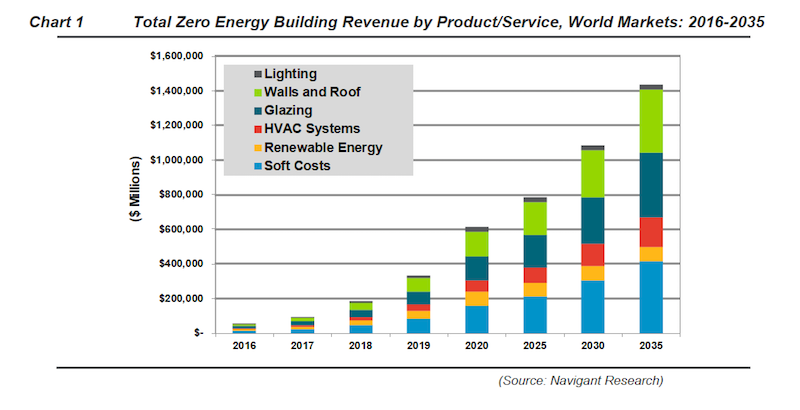The global market for products and services related to achieving net zero energy in residential and commercial construction and renovation is projected to expand at a compound annual growth rate of 44.5% between 2014 and 2035, and exceed $1.4 trillion in that last year, according to the latest estimates in a new 24-page report, titled Net Zero Energy Buildings, published by Navigant Research.
In North America alone, that market is projected to increase annually at a rate of 38.4% during that timeframe, reaching more than $127 billion in 2035.
Once confined mostly to single-family home and one-story office construction, net zero energy (ZNE) is penetrating a nonresidential sector that is placing greater emphasis on efficiency, renewable energy, and consumption. The Navigant report contends that the technology needed to achieve net zero energy is available for almost any building type.
Benjamin Freas, Navigant’s Principal Research Analyst in Washington, D.C., tells BD+C that the regulatory climate, both in North America and worldwide, is leaning in directions that favor ZNE construction practices. He points specifically to California’s Title 24, which went into effect on January 1 and sets minimum energy saving requirements for new buildings and renovations. By 2030, all new commercial construction in California must be ZNE, meaning that those buildings produce at least as much energy onsite as they consume.
Freas concedes that commercial ZNE so far is in the “pilot program phase” and is being being adopted “jurisdiction by jurisdiction, state by state.” But he’s convinced that the actions of “forward-thinking” states such as California, Massachusetts, and New York will ultimately result in regional and national code changes.
Freas also points to the Paris Climate agreement, which takes effect on November 4, 2017, as a possible turning point for ZNE construction. The pact, with 197 signatories, requires governments to present national plans to reduce emissions to limit global temperature rise to well below 3.6 degrees Fahrenheit. (While President-elect Donald Trump has threatened to pull the U.S. out of that accord, there is less certainty about what impact his administration will have on America’s push toward greater energy efficiency and reducing carbon emissions.)
Another factor in Navigant’s projections is the advocacy of groups like U.S. Green Building Council and the New Buildings Institute that are pressing developers and their AEC partners to entertain ZNE as an option in their design and construction plans.
Freas observes that ZNE is starting to seep into AEC continuing education programming. However, he admits that educating the industry about the benefits of ZNE remains “a challenge,” in part because the costs related to making buildings net zero energy are “currently not acceptable to most building owners.”
That being said, Navigant’s research paints a picture of a global market in which ZNE is inevitable and, eventually, ubiquitous.
Glazing, walls and roofs are the biggest potential ZNE areas. Navigant estimates that the value of ZNE products and services for wall and roof construction and renovation will expand to $366.3 billion in 2035, from a mere $134.1 million in 2014. ZNE-related glazing products and services will increase to $369.9 billion from $132.4 million over that same period.
Another big gainer could be ZNE HVAC products and services, which are expected to grow at an annualized rate of 45.8%, to $172.6 billion in 2035.
All told, the global ZNE products and services market is projected to hit $1.436 trillion in 2035, compared to only $629.3 million in 2014.
The North American ZNE market will reach $127.1 billion in 2035, nearly 1,000 times larger than the 137.4 million market at 2014. The walls and roofs sector is expected to increase at an annual rate of 39.6% to $32.3 billion; and ZNE products and services for glazing should increase annually by 39.8% to $32.9 billion.
Related Stories
| Jan 21, 2011
Combination credit union and USO center earns LEED Silver
After the Army announced plans to expand Fort Bliss, in Texas, by up to 30,000 troops, FirstLight Federal Credit Union contracted NewGround (as CM) to build a new 16,000-sf facility, allocating 6,000 sf for a USO center with an Internet café, gaming stations, and theater.
| Jan 21, 2011
Sustainable history center exhibits Fort Ticonderoga’s storied past
Fort Ticonderoga, in Ticonderoga, N.Y., along Lake Champlain, dates to 1755 and was the site of battles in the French and Indian War and the American Revolution. The new $20.8 million, 15,000-sf Deborah Clarke Mars Education Center pays homage to the French magasin du Roi (the King’s warehouse) at the fort.
| Jan 21, 2011
Virginia community college completes LEED Silver science building
The new 60,000-sf science building at John Tyler Community College in Midlothian, Va., just earned LEED Silver, the first facility in the Commonwealth’s community college system to earn this recognition. The facility, designed by Burt Hill with Gilbane Building Co. as construction manager, houses an entire floor of laboratory classrooms, plus a new library, student lounge, and bookstore.
| Jan 21, 2011
Upscale apartments offer residents a twist on modern history
The Goodwynn at Town: Brookhaven, a 433,300-sf residential and retail building in DeKalb County, Ga., combines a historic look with modern amenities. Atlanta-based project architect Niles Bolton Associates used contemporary materials in historic patterns and colors on the exterior, while concealing a six-level parking structure on the interior.
| Jan 21, 2011
Research center built for interdisciplinary cooperation
The Jan and Dan Duncan Neurological Research Institute at Texas Children’s Hospital, in Houston, the first basic research institute for childhood neurological diseases, is a 13-story twisting tower in the center of the hospital campus.
| Jan 4, 2011
6 green building trends to watch in 2011
According to a report by New York-based JWT Intelligence, there are six key green building trends to watch in 2011, including: 3D printing, biomimicry, and more transparent and accurate green claims.
| Jan 4, 2011
LEED standards under fire in NYC
This year, for the first time, owners of 25,000 commercial properties in New York must report their buildings’ energy use to the city. However, LEED doesn’t measure energy use and costs, something a growing number of engineers, architects, and landlords insist must be done. Their concerns and a general blossoming of environmental awareness have spawned a host of rating systems that could test LEED’s dominance.
| Jan 4, 2011
LEED 2012: 10 changes you should know about
The USGBC is beginning its review and planning for the next version of LEED—LEED 2012. The draft version of LEED 2012 is currently in the first of at least two public comment periods, and it’s important to take a look at proposed changes to see the direction USGBC is taking, the plans they have for LEED, and—most importantly—how they affect you.
| Jan 4, 2011
California buildings: now even more efficient
New buildings in California must now be more sustainable under the state’s Green Building Standards Code, which took effect with the new year. CALGreen, the first statewide green building code in the country, requires new buildings to be more energy efficient, use less water, and emit fewer pollutants, among many other requirements. And they have the potential to affect LEED ratings.











